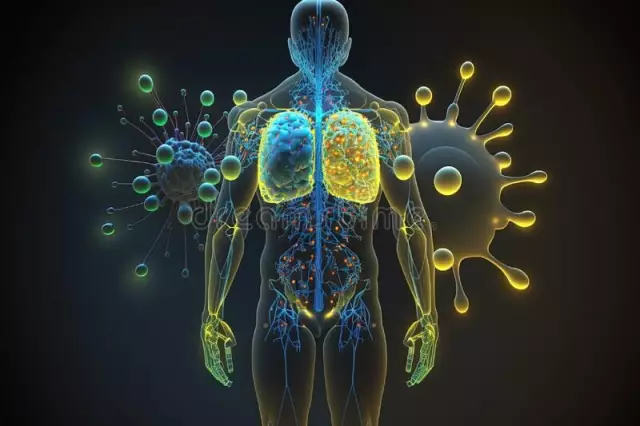- Author Curtis Blomfield [email protected].
- Public 2023-12-16 20:44.
- Last modified 2025-01-23 17:01.
When chronic infections, allergies and autoimmune diseases are suspected, doctors prescribe a circulating immune complex (CIC) test. This study allows you to determine the stage of the inflammatory process. Such a test is usually carried out in combination with other immunological tests. What indicators of analysis are considered the norm? And what causes the increase in the level of the CEC? We will consider these issues in the article.
What is this
When a foreign protein (antigen) enters the body, the immune cells begin to produce special globulins. In this case, circulating immune complexes appear in the blood. They are macromolecular compounds that appear when antibodies interact with antigens.

Normally, these compounds are quickly removed from the body through phagocytes. The complexes are also destroyed in the liver and spleen. For some pathologies,excretion from the body slows down. If the concentration of such substances becomes excessively high, then there is a risk of CEC deposition in the tissues. This can provoke an inflammatory process.
What test should I take
How to determine the concentration of circulating immune complexes? To do this, you need to pass a special blood test at the CEC. Such an immunological study is carried out in many clinical laboratories. This test is prescribed for the following purposes:
- for the diagnosis of inflammatory processes that develop as a result of CEC deposition in tissues;
- to determine the etiology of allergies;
- to detect autoimmune diseases;
- for monitoring the patient's condition with glomerulonephritis and chronic infections;
- to evaluate the effectiveness of the prescribed treatment.
It is important to remember that it is impossible to judge the exact concentration of CEC in tissues from the results of this study. The test data allow only to assess the degree of activity of the inflammatory process.
Indications
A blood test for circulating immune complexes is prescribed for suspected diseases:
- systemic lupus erythematosus;
- scleroderma;
- joint inflammation;
- polymyositis;
- glomerulonephritis;
- allergy;
- serum sickness.
Indications for a CEC test are also chronic persistent infections. This is the name of pathologies provoked by the constant presence of viruses, fungi and bacteria in the body.

Preparing for the test
This analysis is taken in the morning before meals. A few days before the delivery of the biomaterial, the following rules must be observed:
- refuse to eat fatty foods;
- do not drink alcohol;
- avoid physical and emotional strain;
- quit smoking 2-3 hours before donating blood.
How the analysis is done
The study takes blood from a vein. The biomaterial is placed in a sealed tube and delivered to the laboratory. It is processed in a centrifuge and the plasma is separated from the formed elements.

Plasma is examined by enzyme immunoassay. A special substance, complement C1q, is added to a test tube with blood serum. This is a protein that interacts with the CEC. After that, using a photometer, measure the density of the solution. Based on these data, the number of circulating immune complexes is calculated. A transcript of the analysis can be received in your hands approximately 2-4 days after the sample was taken.

Norms
As mentioned, this study does not indicate the concentration of CEC in tissues. The test results only indicate the level of these compounds in the blood plasma. It is also important to remember that laboratories use different CEC units.
The concentration of circulating immune complexes can normally range from 0 to 120 RU (relative units) per 1 ml of serum. The CEC indicator can also be measured in terms ofunits (c.u.). Valid values are from 0.055 to 0.11 c.u.
In children, the rate of circulating immune complexes is the same as in adults. The reference values of this test do not depend on the age of the patient.
Reason for increase
For what reasons can the CEC be raised? Deviations from the norm upwards can be observed in various diseases. Such pathologies can be divided into 3 groups:
- allergic reactions;
- autoimmune processes;
- penetration of infection.
The first group of diseases is caused by the introduction of foreign antigens into the body. With allergies, the CEC is formed in an increased amount. The body does not have time to remove these compounds. These pathologies include:
- allergic drug reactions;
- serum sickness (hypersensitivity to vaccines, sera and blood components);
- allergic inflammation of the alveoli of the lungs (reaction to inhalation of allergens);
- allergy after insect bite;
- Dühring's dermatitis herpetiformis (skin lesion with the formation of a blistering rash).

Autoimmune processes often cause an increase in the CEC. In rheumatic diseases, immune complexes are deposited in the tissues and cause inflammation. This is noted in the following pathologies:
- systemic lupus erythematosus;
- scleroderma;
- glomerulonephritis (lupus);
- rheumatoid arthritis;
- periarteritis nodosa;
- Crohn's disease;
- Sjogren's syndrome;
- systemic vasculitis;
- autoimmune thyroid inflammation.

In addition, bacterial, viral and fungal infections can cause an increase in CEC indicators. When the pathogen enters the body, a large number of antigen-antibody complexes are formed. They are not always completely eliminated from the body and accumulate in the plasma. Also, the cause of a high level of the CIC are malignant tumors and parasitic pathologies.
Increased levels of immune complexes are noted in patients who have undergone organ transplants. In this case, this does not indicate a poor prognosis of the disease.
Decrease in performance
If during the initial analysis the circulating immune complexes in the patient are lowered, then this does not indicate pathology. The CEC indicator may even be zero. This value is a variant of the norm.
If the patient had a high level of CEC in the past, then a decrease in the indicator is a favorable sign. This suggests that the therapy has given positive results.
Additional Research
In case of deviations in the CEC parameters, the patient is prescribed an immunogram. This is an extended blood test that shows the state of the body's defenses. Often, the analysis for the CEC is carried out as part of this test.
One of the most important indicators of this test is the activity of phagocytosis. It is thanks to the activity of phagocyte cells thatexcretion of circulating immune complexes from the body. The norm (as a percentage) of phagocytosis activity is considered to be from 65 to 95%.
The more phagocytosis activity is reduced in a patient, the more CEC accumulates in tissues. In addition, when conducting an immunogram, the number of lymphocytes, immunoglobulins, markers of macrophages and monocytes is evaluated, and the leukocyte formula is determined. Such a comprehensive study allows you to obtain detailed data on the state of the immune system.
The results of the immunogram must be shown to the attending physician (rheumatologist, infectious disease specialist, allergist, immunologist). Depending on the alleged diagnosis, the patient will be prescribed appropriate treatment.






